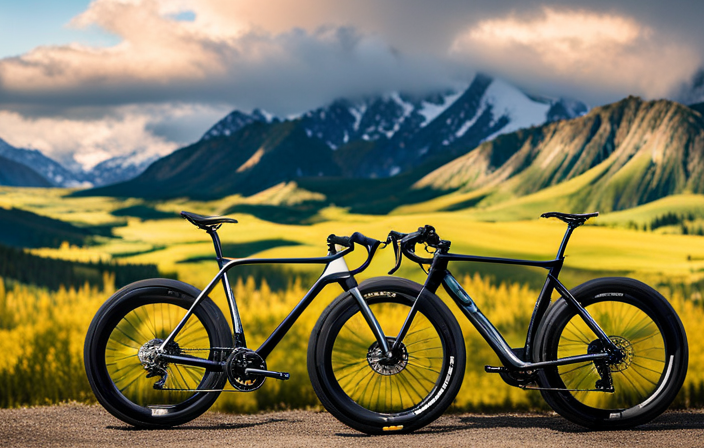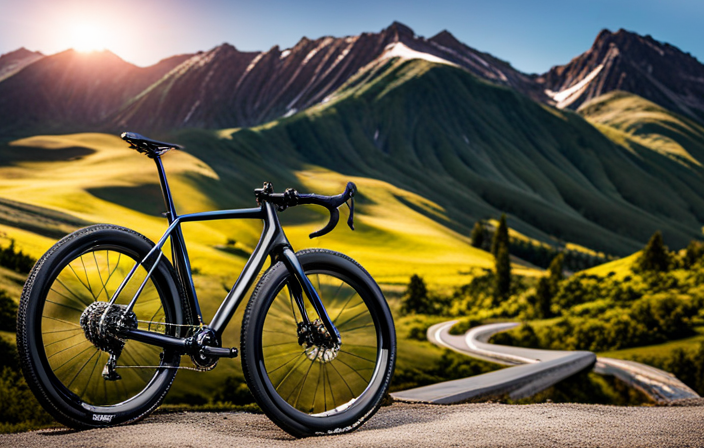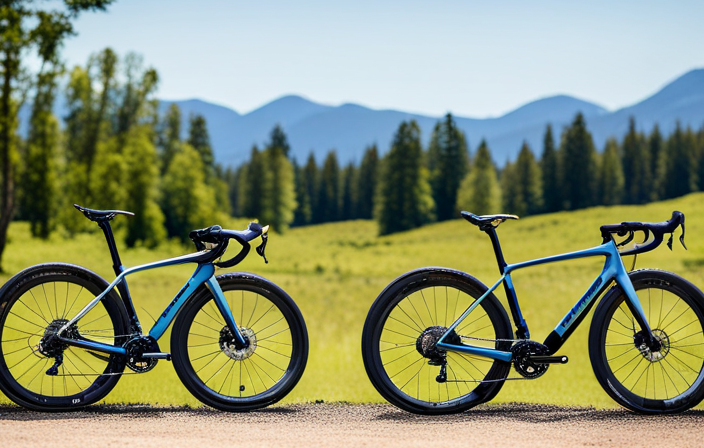You’ve heard the saying: ‘Not all bikes are the same.’ This rings especially true for **gravel bikes**. Want to find out why? Continue reading to discover the secrets behind **what sets gravel bikes apart**.
These two-wheeled wonders have taken the cycling world by storm, offering a unique combination of features and capabilities that set them apart from traditional road or mountain bikes.
From their versatile frame geometry to their wider tires and enhanced suspension, gravel bikes are purpose-built for off-road adventures and exploration.
So strap on your helmet and get ready to discover what makes a gravel bike different in this detailed and technical exploration.
Key Takeaways
- Gravel bikes have versatile frame geometry, with adjustable dropouts and mounting points for accessories.
- Gravel bikes have wider tires for increased stability, traction, and comfort.
- Gravel bikes are equipped with disc brakes for reliable stopping power and reduced maintenance.
- Gravel bikes offer different handlebar options and lower gear ratios for easier climbing and varied terrains.
Versatile Frame Geometry
You’ll notice that gravel bikes have a versatile frame geometry, allowing you to easily switch between different riding styles and terrains. This is one of the key features that sets them apart from other types of bikes. Gravel bike frames are designed to be sturdy yet lightweight, providing the perfect balance between durability and speed. They are usually made from materials such as aluminum or carbon fiber, which offer strength and resilience while keeping the overall weight down.
In addition to frame materials, gravel bikes also come with a variety of accessories that enhance their versatility. These include mounts for racks and fenders, allowing you to carry extra gear or protect yourself from mud and debris when riding on rough surfaces. Some models even feature adjustable dropouts, which enable you to modify the bike’s geometry according to your preferences.
By having a versatile frame geometry and equipped with these accessories, gravel bikes can handle an array of riding conditions. From smooth pavement to rugged off-road trails, they excel in providing stability and control.
Speaking of stability, another important aspect of gravel bikes is their ability to accommodate wider tires. This feature will be discussed in more detail in the subsequent section about ‘wider tires for increased stability’.
Wider Tires for Increased Stability
To enhance stability, opt for wider tires on your gravel ride. Wider tires provide several benefits that can greatly improve your riding experience.
Increased traction: With wider tires, you have a larger contact patch with the ground, allowing for better grip and traction on loose or uneven surfaces. This gives you more confidence to tackle challenging terrains without worrying about losing control.
Improved stability: The wider surface area of the tire provides enhanced stability, particularly when cornering or descending at high speeds. This stability translates to a smoother and more controlled ride, allowing you to navigate through obstacles with ease.
Enhanced comfort: Wider tires also offer improved shock absorption capabilities, reducing the impact of rough roads and trails on your body. This results in a more comfortable ride, minimizing fatigue and enabling you to go further for longer periods.
To fully reap the benefits of wider tires, it is important to optimize their pressure based on factors such as rider weight and terrain conditions. Adjusting tire pressure allows you to fine-tune the balance between grip and rolling resistance for optimal performance.
With wider tires providing increased stability and comfort, the next step is exploring how enhanced suspension can further enhance your off-road performance.
Enhanced Suspension for Off-Road Performance
Enhanced suspension on your off-road ride can greatly improve your overall performance. When it comes to tackling rough terrain and unpredictable surfaces, having a capable off-road suspension system is essential. Off-road suspension refers to the components that absorb shocks and vibrations from the ground, allowing the bike to maintain traction and stability. These include forks in the front and sometimes rear shocks in the back.
Off-road suspension systems are designed to handle the demands of gravel riding, providing increased comfort, control, and confidence when navigating challenging terrain. They help smooth out bumps and reduce jarring impacts, allowing you to maintain better control over your bike. By absorbing most of the shock from uneven surfaces, an enhanced suspension system reduces fatigue on your body during longer rides.
The benefits of off-road suspension extend beyond comfort alone; they also enhance your performance. With improved traction and stability provided by a well-designed suspension system, you can tackle rough trails with greater speed and precision. This translates into better handling, faster cornering speeds, and ultimately a more enjoyable off-road experience.
Speaking of improved performance, another important feature that contributes to an exceptional gravel ride is reliable stopping power. Disc brakes provide just that – dependable braking performance regardless of weather or surface conditions.
Disc Brakes for Reliable Stopping Power
One key component that significantly improves off-road performance is the use of disc brakes. They provide reliable stopping power in any weather or surface conditions. Disc brakes have become increasingly popular on gravel bikes due to their numerous advantages over traditional rim brakes. Here are three reasons why disc brakes are superior:
-
Reduced Maintenance: Unlike rim brakes, disc brakes are not affected by wet or muddy conditions. The rotors and calipers are located away from the ground and wheel rims, reducing the chances of debris buildup and brake pad wear. This means less time spent cleaning and adjusting your brakes, allowing you to focus more on enjoying your ride.
-
Improved Modulation: Disc brakes offer precise control over braking force. With a simple squeeze of the lever, you can easily modulate the amount of braking power applied. This level of control is particularly useful when navigating technical descents or loose surfaces where sudden stops could lead to loss of traction.
-
Increased Stopping Power: Disc brakes deliver superior stopping power compared to rim brakes. The larger rotors and hydraulic or mechanical calipers provide more leverage, resulting in shorter stopping distances. This enhanced stopping capability gives riders greater confidence when tackling steep descents or unpredictable terrain.
With reduced maintenance requirements and improved modulation, disc brakes offer a significant advantage for gravel bike riders seeking reliable stopping power in challenging off-road conditions.
Moving forward into our next section about increased clearance for gravel and rough terrain…
Increased Clearance for Gravel and Rough Terrain
When riding off-road, you’ll appreciate the increased clearance of your gravel bike for navigating rough terrain. This feature allows you to tackle gravel paths, rocky trails, and even muddy sections with confidence. Unlike road bikes or mountain bikes, gravel bikes are specifically designed to handle these challenging conditions.
The increased clearance on a gravel bike is achieved by using larger tires and modifying the frame geometry. With more space between the frame and the tires, you can ride over bumps and obstacles without worrying about hitting them. Additionally, this extra room allows you to increase tire pressure for reduced rolling resistance on smoother surfaces.
By having increased tire pressure, you’ll experience faster speeds on flat roads as it reduces friction between the tire and the ground. This improved efficiency means less energy wasted while pedaling, ultimately resulting in a more enjoyable riding experience.
Now that we’ve covered how increased clearance benefits your off-road adventures, let’s talk about another important feature of gravel bikes: mounting points for bikepacking accessories. These additional attachment points make it easier to carry gear like saddlebags or frame bags when embarking on longer trips. So let’s dive into how these mounting points enhance your gravel biking experience!
Mounting Points for Bikepacking Accessories
To make your bikepacking adventures easier, you’ll love the additional mounting points on a gravel bike for attaching accessories like saddlebags or frame bags. These versatile mounting options allow you to carry all the necessary gear for your trip, ensuring that you have everything you need while exploring new trails and rough terrains.
Here are five reasons why these mounting points on a gravel bike are a game-changer for bikepacking enthusiasts:
-
Increased Storage Capacity: With multiple attachment points, you can easily expand your carrying capacity and bring along extra supplies or equipment.
-
Customizable Setup: The various mounting positions let you configure your gear arrangement based on personal preference and weight distribution.
-
Enhanced Stability: By distributing the weight evenly across the bike, the additional mountings provide better balance and stability, especially when tackling challenging terrain.
-
Accessibility: Having readily accessible storage options allows quick access to essential items while riding without disrupting your momentum.
-
Versatility: These mountings accommodate a wide range of bikepacking gear options, such as water bottle cages, tool kits, sleeping bag holders, or even racks for panniers.
With these benefits in mind, it’s clear that having ample mounting points on a gravel bike opens up endless possibilities for comfortable and efficient bikepacking experiences.
Now let’s dive into another crucial aspect of gravel bikes—their comfortable and ergonomic handlebars.
Comfortable and Ergonomic Handlebars
The comfortable and ergonomic handlebars on a gravel bike provide a more enjoyable riding experience. The design of these handlebars takes into consideration the natural position of the hands, wrists, and arms, reducing strain and discomfort during long rides. There are various handlebar options available for gravel bikes, each offering its own unique benefits.
To highlight the different handlebar options for gravel biking, let’s take a look at a comparison table:
| Handlebar Type | Description | Benefits |
|---|---|---|
| Drop Bars | Curved shape with multiple hand positions | Aerodynamic, efficient on paved roads |
| Flat Bars | Straight across with one hand position | More control and stability on rough terrain |
| Flared Drop Bars | Similar to drop bars but with outward flare | Enhanced leverage for better control in technical areas |
These handlebar options cater to different riding styles and preferences. Whether you prioritize speed on paved roads or seek better control on rugged off-road trails, there is a suitable option for you.
With our understanding of comfortable and ergonomic handlebars covered, we can now delve into lower gear ratios for climbing steep hills without missing a beat.
Lower Gear Ratios for Climbing Steep Hills
When it comes to gravel biking, comfort is key. Having comfortable and ergonomic handlebars can make a world of difference in your riding experience. But that’s not the only factor that sets gravel bikes apart.
Another important feature is their lower gear ratios for climbing steep hills. Climbing on a gravel bike requires different techniques compared to road or mountain biking. The terrain can be unpredictable and challenging, so having lower gears is essential for maintaining traction and power while ascending steep inclines.
With lower gear ratios, you can spin the pedals at a higher cadence, making it easier to climb without putting too much strain on your legs. Gear selection plays a crucial role in conquering those tough climbs. Gravel bikes often come equipped with wide-range cassette options and compact cranksets that provide ample low-end gearing for tackling even the steepest hills. This allows riders to maintain momentum and conquer varied terrain with ease.
Now that we’ve covered the importance of lower gear ratios for climbing steep hills, let’s move on to another key aspect of gravel bikes: their durable construction for longevity.
Durable Construction for Longevity
One important aspect of gravel bikes is their durable construction, which ensures longevity and reliability. Gravel biking involves riding on rough, unpredictable terrains, and a bike that can withstand such conditions is essential. The construction materials used in gravel bikes are carefully chosen to provide maximum durability and minimize the risk of damage.
To highlight the benefits of durable construction, let’s take a look at the following table:
| Construction Material | Longevity Benefits |
|---|---|
| Carbon Fiber | Lightweight yet strong material that absorbs shocks effectively. Provides excellent durability over long distances. |
| Aluminum | Offers good stiffness and strength while being more affordable than carbon fiber. It can handle rugged terrains without compromising longevity. |
| Steel | Known for its durability and resilience, steel frames excel in absorbing vibrations from rough surfaces, ensuring a comfortable ride that lasts for years. |
These construction materials contribute significantly to the bike’s ability to handle various terrains with ease and reliability. With their robustness, gravel bikes can tackle not only steep hills but also rocky paths and muddy trails without hesitation or compromise in performance.
Ability to Handle Various Terrains
You can confidently ride your gravel bike on a wide range of terrains, knowing that it will handle them all with ease and reliability. Gravel bikes are designed to be versatile and capable, allowing you to explore off-road trails, tackle rocky paths, and even navigate through muddy sections.
Here’s why gravel bikes excel at handling various terrains:
-
Wider Tires: Gravel bikes are equipped with wider tires compared to traditional road bikes. These wider tires provide better traction and stability on loose surfaces like gravel or dirt.
-
Rugged Frame: The durable construction of a gravel bike ensures it can withstand the rigors of off-road riding. With its robust frame made from materials like aluminum or carbon fiber, it can handle rough terrains without compromising performance.
-
Suspension Options: Some gravel bikes come with suspension forks or seatposts that absorb shocks and vibrations, enhancing comfort on bumpy trails.
-
Versatile Gearing: Gravel bikes typically have a wide range of gears that allow you to conquer steep climbs and power through flat sections effortlessly.
These features make gravel bikes ideal for bikepacking essentials or participating in thrilling gravel bike races. They offer the perfect balance between speed and durability, enabling riders to push their limits in different conditions.
With its ability to handle various terrains, a gravel bike is suitable for both on-road and off-road riding adventures seamlessly.
Suitable for Both On-Road and Off-Road Riding
A gravel bike’s versatility allows me to seamlessly transition between on-road and off-road riding adventures. One of the key features that make a gravel bike suitable for both types of terrain is its off-road capabilities. These bikes are designed with wider tires, typically ranging from 35mm to 45mm, which provide better traction and stability on loose surfaces like dirt, gravel, or sand. The frame geometry of a gravel bike also plays a role in its ability to handle different terrains. It strikes a balance between road bikes and mountain bikes, offering a more relaxed riding position for comfort during long rides while still maintaining agility for off-road maneuverability.
The versatility of a gravel bike goes beyond just handling various terrains; it also allows me to explore different routes and adventure possibilities. Whether I’m commuting on paved roads or taking the path less traveled through wooded trails or country lanes, my gravel bike can handle it all. This adaptability is what makes it such a popular choice among cyclists who crave versatility and want the freedom to explore new areas without limitations.
With its off-road capabilities and versatility, a gravel bike provides increased control and stability on loose surfaces compared to traditional road bikes. This transition into the subsequent section highlights how these features contribute to an enhanced riding experience when facing challenging conditions such as loose gravel or uneven terrain.
Increased Control and Stability on Loose Surfaces
When riding on loose surfaces, it’s crucial to have a bike that offers increased control and stability. This is where gravel bikes truly shine. With their design and features specifically tailored for off-road riding, these bikes provide the necessary tools to tackle various terrains with confidence.
One of the key factors that contribute to the increased control and stability of gravel bikes on loose surfaces is their larger tire width. Compared to road bikes, gravel bikes typically have wider tires with increased traction capabilities. This allows riders to maintain better grip on loose or uneven terrain, preventing slippage and enhancing overall control.
In addition to tire width, gravel bikes often feature advanced suspension systems or dampening technologies that further improve stability on rough surfaces. These systems absorb shocks and vibrations effectively, minimizing the impact on the rider’s body and providing a smoother ride.
With their enhanced control and stability, gravel bikes are well-suited for navigating through challenging conditions such as sandy paths, muddy trails, or gravelly roads. They allow riders to confidently tackle off-road adventures while maintaining balance and reducing the risk of accidents.
Transitioning into the next section about adaptability for different riding styles… Gravel bikes not only excel in offering increased traction and improved stability but also possess remarkable adaptability for different riding styles.
Adaptability for Different Riding Styles
Gravel bikes excel in their ability to adapt to various riding styles. One of the key factors that contribute to this adaptability is the use of different frame materials.
Gravel bikes are typically made from lightweight and durable materials such as carbon fiber, aluminum, or steel. Each material has its own unique characteristics that can enhance the performance and handling of the bike.
Carbon fiber frames are known for their stiffness and responsiveness, making them ideal for riders who prioritize speed and agility.
Aluminum frames, on the other hand, offer a balance between weight and affordability, making them a popular choice among entry-level riders.
Steel frames provide a smooth and comfortable ride, absorbing vibrations from rough terrain.
In addition to frame materials, gravel bike components also play a crucial role in their adaptability. Components like wider tires with knobs provide better traction on loose surfaces, while disc brakes offer superior stopping power in all weather conditions.
The geometry of gravel bikes is also designed to be more stable and forgiving than road bikes, allowing riders to confidently tackle challenging terrains.
Overall, the combination of different frame materials and carefully chosen components make gravel bikes versatile enough to handle various riding styles. With their ability to adapt to different terrains and conditions, gravel bikes are ideal for adventure and exploration without sacrificing comfort or performance.
Ideal for Adventure and Exploration
If you’re looking for a bike that is perfect for adventure and exploration, look no further than a gravel bike. This versatile machine is designed to handle various terrains and weather conditions, making it ideal for those who want to venture off the beaten path. With its durability and stability, a gravel bike allows riders to go where traditional road bikes cannot.
One of the reasons why a gravel bike is great for adventure and exploration is its adaptability to different riding styles. Whether you prefer long-distance touring, overnight camping trips, or off-road adventures, this bike can handle it all. Its wide tires provide excellent traction on both pavement and rough trails, ensuring a smooth ride no matter the terrain.
To illustrate the benefits of a gravel bike for adventure and exploration, let’s take a look at this comparison table:
| Adventure Gear | Exploration Benefits |
|---|---|
| Bikepacking bags | Carry essential gear |
| Tubeless tires | Reduced risk of flats |
| Disc brakes | Reliable stopping power |
As you can see, these features make a gravel bike well-suited for outdoor escapades. Now let’s delve into the growing popularity and availability of gravel bikes in the cycling community.
(Note: Transition sentence into subsequent section) As more cyclists discover the thrill of exploring new routes and challenging themselves in different environments with their gravel bikes…
Growing Popularity and Availability in the Cycling Community
You’ll be amazed at how popular and readily available gravel bikes have become in the cycling community. In recent years, there has been a significant surge in interest for these versatile machines, leading to a growing popularity and increased availability.
One of the reasons behind this boom is the desire among cyclists to explore new terrains and go on adventurous rides. Gravel bikes offer the perfect solution, as they are designed to handle various surfaces such as dirt roads, gravel paths, and even rough trails. Their ability to tackle different terrains with ease has attracted riders who seek thrilling experiences beyond traditional road cycling.
Moreover, manufacturers have recognized this trend and responded by producing a wider range of gravel bike models. This increased availability means that enthusiasts can now choose from an extensive selection of options to suit their specific preferences and needs. From entry-level models for beginners to high-end options for experienced riders, there is something for everyone.
The growing popularity of gravel biking has also led to the development of dedicated events and races around the world. These events provide opportunities for riders to showcase their skills on mixed-terrain courses while fostering a sense of community within the gravel cycling scene.
In conclusion, it’s clear that gravel bikes have gained immense popularity due to their ability to facilitate adventure and exploration on diverse terrains. With their increased availability in the market, more cyclists can enjoy the thrill and excitement of riding off-road with confidence and style.
Frequently Asked Questions
What are some common bikepacking accessories that can be mounted on a gravel bike?
When it comes to bikepacking gear, there are several essential gravel bike accessories that can be mounted on your bike. These include a handlebar bag for storing lightweight items like snacks and a small hydration pack.
A frame bag is also crucial for carrying heavier gear such as tools and spare parts. Additionally, a seat pack provides extra storage space for bulkier items like clothing and sleeping gear.
Overall, these accessories help optimize your gravel biking experience by ensuring you have all the necessary equipment conveniently within reach.
How does the increased clearance on a gravel bike affect its performance on rough terrain?
The increased clearance on a gravel bike is a game-changer when it comes to tackling rough terrain. It allows for larger tires, which provide better traction and stability.
With this extra clearance, I can confidently ride over rocks, roots, and uneven surfaces without worrying about getting stuck or losing control.
The improved performance on rough terrain is unmatched, making the gravel bike the ultimate off-road companion.
Can a gravel bike be used for commuting or road cycling as well?
Yes, a gravel bike can definitely be used for daily commuting. It offers the versatility to handle both off-road and on-road conditions, making it suitable for various terrains encountered during a commute.
While a gravel bike may not be as efficient as a road bike for long distance cycling due to its wider tires and heavier frame, it still provides a comfortable and enjoyable riding experience on longer rides with mixed surfaces compared to a traditional road bike.
What are the advantages of having disc brakes on a gravel bike compared to other types of brakes?
The advantages of disc brakes on a gravel bike compared to other types of brakes are numerous. Disc brakes provide consistent and reliable stopping power, even in wet or muddy conditions. They also allow for better modulation, meaning you can easily control your braking force.
Additionally, disc brakes require less maintenance and are not affected by rim wear.
When it comes to gravel riding, tire choice is crucial as well. Opting for wider tires with a lower pressure will provide better traction and stability on loose surfaces.
How does the versatile frame geometry of a gravel bike contribute to its adaptability for different riding styles?
In terms of adaptability, the versatile frame geometry of a gravel bike plays a crucial role.
The frame geometry refers to the angles and dimensions of the frame, which greatly affects how the bike handles different terrains and riding styles.
For example, a gravel bike typically has a longer wheelbase and slacker head tube angle compared to a road bike. This allows for more stability and control when navigating rough terrain or descending steep hills.
Additionally, the higher bottom bracket clearance provides ample space for larger tires, enhancing off-road capabilities.
Conclusion
So, after exploring the various features that make a gravel bike different, it is clear that these bikes are designed for adventure and exploration on rough terrains. They offer enhanced stability, control, and adaptability which allows riders to tackle any kind of riding style.
While some may argue that gravel bikes are too specialized and not suitable for everyday use, it’s important to remember that they provide a unique experience and open up a world of possibilities for those seeking thrill and excitement in their cycling journeys.
Don’t let fear hold you back from the exhilarating world of gravel biking!









